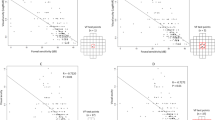Abstract
An interferometric acuity device (Takata) has been used to study visual resolution in individuals with possible demyelinating disease. The instrument employed provides a large field with a continuous range of grid or fringe frequencies and a relatively intense (105 mean photopic trolands) stimulus. After a brief period of time with eyes closed, resolution thresholds of patients are repeatedly determined during a five minute period. In all individuals suspected of having a demyelinating disease tested to date, a fall off in resolution capability has been found in time when using this intense stimulus display. This occurs whether eye signs have been present, are present or have not yet been observed. Normal observers do not exhibit comparable decrements. The fall off in resolution capability may or may not occur at lower stimulus levels, and is often not revealed when testing routine Snellen acuity. Outer and inner retinal pathology (division based on vascular support) do not cause a comparable fall off in resolution in time. The interferometric acuity test is a non-invasive, easily applied test.
Similar content being viewed by others
References
Enoch, J. M., H. E. Bedell, E. C., Campos, Visual resolution in a patient exhibiting a visual fatigue or saturationlike effect: Probable Multiple Sclerosis, A. M. A. Archives of Ophthal., in press.
Enoch, J. M., R. Sunga, Development of quantitative perimetric tests, Hans Goldmann Festschrift, Documenta Ophthalmologica 26: 215–229, (1969).
Sunga, R., J. M. Enoch, Further perimetric analysis of patients with lesions of the visual pathways, American J. Ophthal. 70: 403–422, (1970).
Enoch, J. M., R. Berger, R. Birns, A static perimetric technique believed to test receptive field properties: Extension and Verification of the Analysis, Documenta Ophthalmologica 29: 127–154, (1970).
Zappia, R. et al., The Riddock phenomenon revealed in non-occipital lobe lesions, British J. Ophthalmol 55: 416–420, (1971).
Enoch, J. M., Quantitative layer-by-layer perimetry, The Francis I. Proctor Lecture, 1977, Investigative Ophthal. 17: 199–257, 1978.
Heron, J., D. Regan, N. Milner, Delay in visual perception in unilateral optic atrophy after retrobulbar neuritis, Brain 97: 83–92, 1974; see also
Galvin, R. J., D. Regan, J. Heron, Impaired temporal resolution of vision after acute retrobulbar neuritis, Brain 99: 255–268, (1976).
Galvin, R., J. Heron, D. Regan, subclinical optic neuropathy in multiple sclerosis, Arch. Neurology, in press.
Author information
Authors and Affiliations
Additional information
This research has been supported in part by National Eye Institute Research Grant No. EY 01418, and Training Grant No. EY 07046 (to JME), National Institutes of Health, Bethesda, Maryland, and in part by a Fellowship supported by Fight for Sight, Inc., New York, in tribute to the memory of Hermann Burian, M. D. (to ECC).
Rights and permissions
About this article
Cite this article
Enoch, J.M., Campos, E.C., Greer, M. et al. Measurement of visual resolution at high luminance levels in patients with possible demyelinating disease. Int Ophthalmol 1, 99–104 (1979). https://doi.org/10.1007/BF00154196
Issue Date:
DOI: https://doi.org/10.1007/BF00154196




